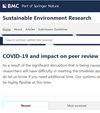rGO/S、N/TiO2组合增强可见光驱动甲苯光催化降解
IF 4.8
3区 环境科学与生态学
Q2 ENGINEERING, ENVIRONMENTAL
引用次数: 6
摘要
甲苯是一种常见的危害人体健康的挥发性有机化合物。因此,甲苯的降解对改善空气质量价值至关重要。二氧化钛是一种典型的光催化剂,在光吸收和电子转移过程中具有优势。在本研究中,通过掺杂还原氧化石墨烯(rGO)、硫和氮(S, N)元素来改进tio2催化剂。在1wt%rGO/S 0.05 N 0.1 tio2的条件下,甲苯的光催化降解效果最好。光催化活性的提高是通过更高的比表面积、含氧官能团的形成和化学缺陷结构来实现的。然而,较高的还原氧化石墨烯添加量会产生屏蔽作用,抑制光的穿透。此外,相对湿度和施加温度分别通过竞争吸附和增加碰撞频率影响光催化活性。在0.1wt%rGO/S 0.05 N 0.1 tio2光催化降解过程中,甲苯转化为苯甲醇、苯甲醛、苯甲酸、水和二氧化碳。本文章由计算机程序翻译,如有差异,请以英文原文为准。
Combination of rGO/S, N/TiO2 for the enhancement of visible light-driven toluene photocatalytic degradation
Toluene is one type of common volatile organic compounds that is harmful to human health. Therefore, the degradation of toluene is critical to improving air quality value. Performance improvement of TiO 2 , a typically applied photocatalyst, has advantages in light absorption and electron transfer process. In this study, the TiO 2 catalyst was improved by the doping of reduced graphene oxide (rGO), sulfur, and nitrogen (S, N) elements. The highest toluene photocatalytic degradation was performed under the composition of 1wt%rGO/S 0.05 N 0.1 TiO 2 . Improvement in photocatalytic activity was achieved by higher specific surface area, formation of oxygen-containing functional group, and chemical defect structure. However, a higher amount of rGO addition creates the shielding effect and inhibits the light penetration. Moreover, the relative humidity and applied temperature influence the photocatalytic activity through the competitive adsorption or increase the collisions frequency, respectively. During the photocatalytic degradation using 0.1wt%rGO/S 0.05 N 0.1 TiO 2 , toluene will be converted into benzyl alcohol, benzaldehyde, benzoic acid, water, and carbon dioxide.
求助全文
通过发布文献求助,成功后即可免费获取论文全文。
去求助
来源期刊

Sustainable Environment Research
Multiple-
CiteScore
8.00
自引率
2.00%
发文量
47
审稿时长
30 weeks
期刊介绍:
The primary goal of Sustainable Environment Research (SER) is to publish high quality research articles associated with sustainable environmental science and technology and to contribute to improving environmental practice. The scope of SER includes issues of environmental science, technology, management and related fields, especially in response to sustainable water, energy and other natural resources. Potential topics include, but are not limited to: 1. Water and Wastewater • Biological processes • Physical and chemical processes • Watershed management • Advanced and innovative treatment 2. Soil and Groundwater Pollution • Contaminant fate and transport processes • Contaminant site investigation technology • Soil and groundwater remediation technology • Risk assessment in contaminant sites 3. Air Pollution and Climate Change • Ambient air quality management • Greenhouse gases control • Gaseous and particulate pollution control • Indoor air quality management and control 4. Waste Management • Waste reduction and minimization • Recourse recovery and conservation • Solid waste treatment technology and disposal 5. Energy and Resources • Sustainable energy • Local, regional and global sustainability • Environmental management system • Life-cycle assessment • Environmental policy instruments
 求助内容:
求助内容: 应助结果提醒方式:
应助结果提醒方式:


